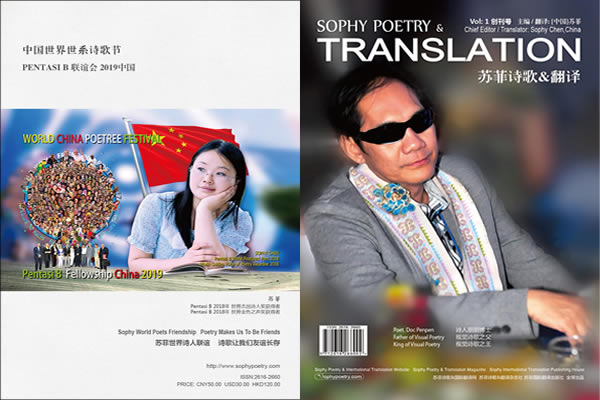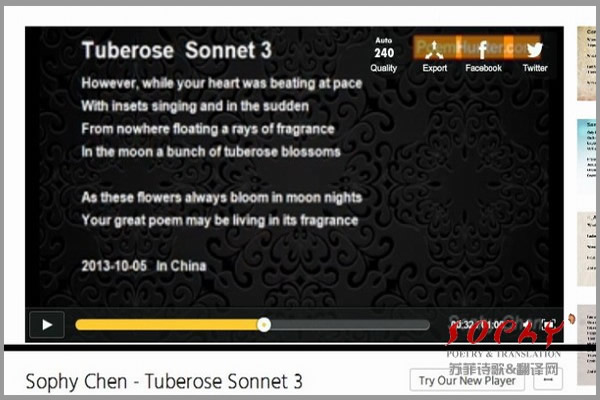苏菲英语十四行诗 与 莎士比亚英语十四行诗 对照分析报告(2.1—2.4)
五步抑扬格 比较分析 待续 ……
作者:苏菲 SOPHY CHEN
Sophy’s English Sonnets and Shakespeare’s English Sonnets’
Iambic Pentameter Comparative Analysis Report
(2.1—2.4)(will be continued)
BY SOPHY CHEN
苏菲 中国 广州 2015-08-16
Sophy Chen Guagnzhou China
苏菲独立编辑报道 “苏菲诗歌&翻译网
Sophy Poetry & Translation Sophy Chen Reported
2.1)我们先用现代英语的读音规律来分析一下 “莎士比亚英语十四行诗”之三。诗文里面实心点表示重读,下划线表示轻读。这里特别说明一下:如果不懂得英语单词重音和句子重音的非英语专业的同学请你们下去补课。这里就不具体讲解为什么下面要这么标记句子重音了。(注意事项:单词下面的实心点和下划线很难编辑到单词正下方,希望大家注意)
莎士比亚十四行诗 之三(原稿)
Sonnet 3
By William Shakespeare
Look in thy glass, and tell the face thou viewest
• — — • — • — • — •
Now is the time that face should form another;
• — — • — • — • — •
Whose fresh repair if now thou not renewest,
— • • — • — • •
Thou dost beguile the world, unbless some mother,
— • • — • • — •
For where is she so fair whose unear’d womb
• — — — • • — • •
Disdains the tillage of thy husbandry?
• • • — • •
Or who is he so fond will be the tomb
• • — — • • — — — •
Of his self-love, to stop posterity?
— • • • — • •
Thou art thy mother’s glass, and she in thee
• — • • • — — — •
Calls back the lovely April of her prime:
• — — • • — • •
So thou through windows of thine age shall see
— • — • — • • — •
Despite of wrinkles this thy golden time.
• — • — • • •
But if thou live, remember’d not to be,
• —• • • • — •
Die single, and thine image dies with thee.
• • — — • • — •
2.2)现在我们严格按照五步抑扬格来分析。“莎士比亚英语十四行诗”之三。下面每个诗行用四个竖线隔开,隔出来的五个部分就是五个音步,就是五个2音节单位。就叫做五步抑扬格,外文名 iambic pentameter。五个2音节单位加起来就十个音节。里面每个竖线隔离出来的单词一个轻读一个重读。轻读是“抑”,重读是“扬”,一轻一重,故称抑扬格。就是“轻——重”格。下面诗文里面,我们还是用实心点表示重读,下划线表示轻读。我们先用这种规则画出读音规则,我朗读出来,再用现代英语语音规则朗读出来看看有什么不同。后来发现语言是动态的,语音流也是动态的。我们如果再用莎士比亚时代的五步抑扬格去读这首诗歌,就感觉比较绕口。不如平时读的顺溜!
莎士比亚十四行诗 之三(原稿)
Sonnet 3
By William Shakespeare
Look in | thy glass |, and tell | the face | thou viewest
— • — • — • — • — •
Now is | the time | that face | should form | another;
— • — • — • — • — •
Whose fresh | repair | if now | thou not | renewest,
— • — • — • — • — •
Thou dost | beguile | the world |, unbless | some mother,
— • — • — • — • — •
For where | is she | so fair | whose u | near’d womb
— • — • — • — • — •
Disdains | the ti | llage of | thy hus | bandry?
— • — • • — — • — •
Or who | is he | so fond | will be | the tomb
— • — • — • — • — •
Of his | self-love |, to stop | poste | rity?
— • — • — • — • — •
Thou art | thy mo | ther’s glass |, and she | in thee
— • — • — • — • — •
Calls back | the love | ly A | pril of | her prime:
— • — • —• — • — •
So thou | through win | dows of | thine age | shall see
— • — • — • — • — •
Despite | of wrin | kles this | thy gol | den time.
— • — • — • — • — •
But if | thou live |, remem | ber’d not | to be,
— • — • — • — • — •
Die sin | gle, and | thine i | mage dies | with thee.
— • — • — • — • — •
2.3)我们再用现代英语的读音规律来分析一下 “苏菲英语十四行诗”之三《晚香玉》Sophy Chen’s Sonnet 3 Buberose。诗文里面实心点表示重读,下划线表示轻读。
苏菲英语十四行诗 之三(原稿)
Sonnet 3 Tuberose
By Sophy Chen
As I was young my mom planted some flowers
• — — • — • • — •
In front of our old wooden house in springs
— — — • • • • — •
In my memory they were peony, China rose…
— • • — — • • •
But what I loved the most was the tuberose
• • • — • — • — — •
In summer night it’s a nice time to me
— • • — — • • — •
You could sit in yard to listen the night birds
— — • — • — • — • •
Singing on cliffs, insects singing in bushes
• — • • • — •
And look at the moon moving in night skies
— • — — • • — • •
However, while your heart was beating at pace
• — • • — • — •
With insects singing and in the sudden
— • • • — — •
From nowhere floating a ray of fragrance
• • • — • — •
In the moon a bunch of tuberose blossoms
— — • — • — • •
As these flowers always bloom in moon nights
— — • • • — • •
Your great poem may be living in its fragrance
• • • — — • — — •
2013-10-05 In China
2.4)现在再严格用五步抑扬格,来分析“苏菲英语十四行诗”之三《晚香玉》Sophy Chen’s Sonnet 3 Buberose。下面每个诗行用四个竖线隔开,隔出来的五个部分就是五个音步,就是五个2音节单位。五个2音节单位加起来就十个音节。里面每个竖线隔离出来的单词一个轻读一个重读。轻读是“抑”,重读是“扬”,一轻一重,故称抑扬格。就是“轻——重”格。下面诗文里面,我们还是用实心点表示重读,下划线表示轻读。
苏菲英语十四行诗 之三(原稿)
Sonnet 3 Tuberose
By Sophy Chen
As I | was young | my mom | planted | some flowers
—• — • — • — • — •
In front | of our | old wood | en house | in springs
— • — • — • — • — •
In my | memo | ry they | were peony |, China rose…
— • — • — • — • — •
But what | I loved | the most | was the | tuberose
— • — • — • — • — •
In su | mmer night | it’s a | nice time | to me
— • — • — • — • — •
You could | sit in | yard to | listen the | night birds
— • — • — • — • — •
Singing | on cliffs |, insects | singing | in bushes
— • — • — • — • — •
And look | at the | moon mo | ving in | night skies
— • — • — • — • — •
However |, while your | heart was | beating | at pace
— • — • — • — • — •
With in | sects sing | ing and | in the | sudden
— • — • — • — • — •
From no | where floa | ting a | ray of | fragrance
— • — • — • — • — •
In the | moon a | bunch of | tuberose | blossoms
— • — • — • — • — •
As these | flowers | always | bloom in | moon nights
— • — • — • — • — •
Your great | poem may | be living | in its | fragrance
— • — • — • — • — •
2013-10-06 In China
从以上重读和轻读的点阵来看,如果用现代英语的读音规则来读,苏菲还未能在“莎士比亚英语十四行诗”中找到一种固定的点阵规律,每首诗歌的点阵变化似乎没有明显的规律。“苏菲英语十四行诗”中也似乎没有固定的点阵规律。也许就如同我在前面说的一样。英语诗句的轻重格或重轻格,其实就是英语句子的句子重音。你如果掌握了英语句子的重音,读起来自然就波浪起伏,优美动听了。英式英语的读音波浪起伏犹如浪涛席卷,美式英语的读音波浪起伏犹如起风的湖泊,波浪不大。当然我们把诗句套到五步抑扬格里面去读的话,那是有着非常严格的点阵规律的,这就看你读的时候是不是要按照这个框框去读了。
待续 ……
![]() ©Translated by Sophy Chen
©Translated by Sophy Chen
翻译版权所有 侵权必究
版权声明
1.苏菲翻译的作品,无论是英译汉还是汉译英,翻译文本版权归译者苏菲所有,未经苏菲书面许可,不得更改翻译文本、重译或将翻译文本转译成其它语言。
2.不得将翻译生成的目标语为汉语或英语的翻译作品(去掉译者姓名后),作为作者自己的原创作品或翻译作品,公开在网络传播、国内外出版物刊印、评奖等。翻译作品如不随附译者姓名以及翻译前后语种,或恶意隐匿译者姓名,一律作侵犯翻译版权处理,网络公开通告并追究法律责任。
3.未经出版者、作者或译者的书面许可,不得翻印、篡编翻译作品或翻译出版物。
4.原创作品的版权归属原作者所有,未经原作者书面许可,任何个人不得更改、抄袭该作品;未经原作者和原出版者书面许可,其它出版机构不得篡编、翻版原出版物。
[ 法律顾问:李刚 ]

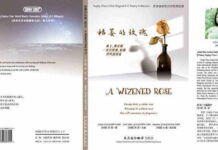




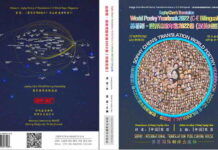
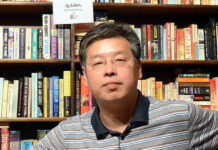


![提名诗人:[中国河南]黄之翊 14首~2023 PENTASI B中国世界诗歌节&苏菲世界诗歌奖](https://www.sophypoetry.net/wp-content/uploads/2023/09/huangzhiyi-218x150.jpg)
![[视频]苏菲获意大利"帕那苏斯"诗歌奖驻华大使殊荣,接受意大利西西里岛媒体现场采访](https://www.sophypoetry.net/wp-content/uploads/2024/04/10-218x150.jpg)







![[视频]苏菲获意大利"帕那苏斯"诗歌奖驻华大使殊荣,接受意大利西西里岛媒体现场采访](https://www.sophypoetry.net/wp-content/uploads/2024/04/10-100x70.jpg)





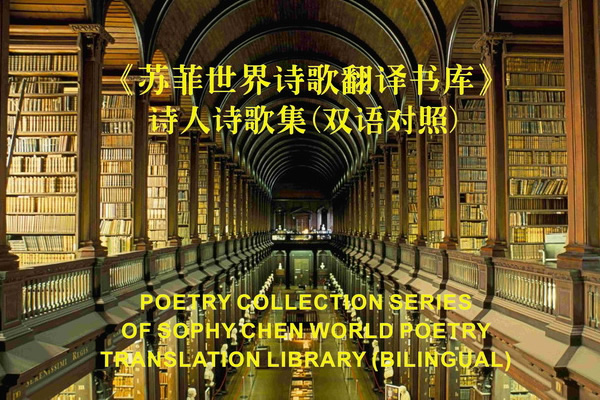

![[视频新闻] 中国诗人、翻译家苏菲荣获意大利聂鲁达诗歌奖](https://www.sophypoetry.net/wp-content/uploads/2021/02/Neruda1-100x70.jpg)

![苏菲第7部汉译英诗集《从眼睛的味道中找到你的美》[中国湖南陈辉(眼睛的味道) 著] 出版发行 苏菲汉译英 中国湖南诗人陈辉(眼睛的味道)诗集 《从眼睛的味道中找到你的美》出版发行](https://www.sophypoetry.net/wp-content/uploads/2019/12/cover-back-CH.jpg)

